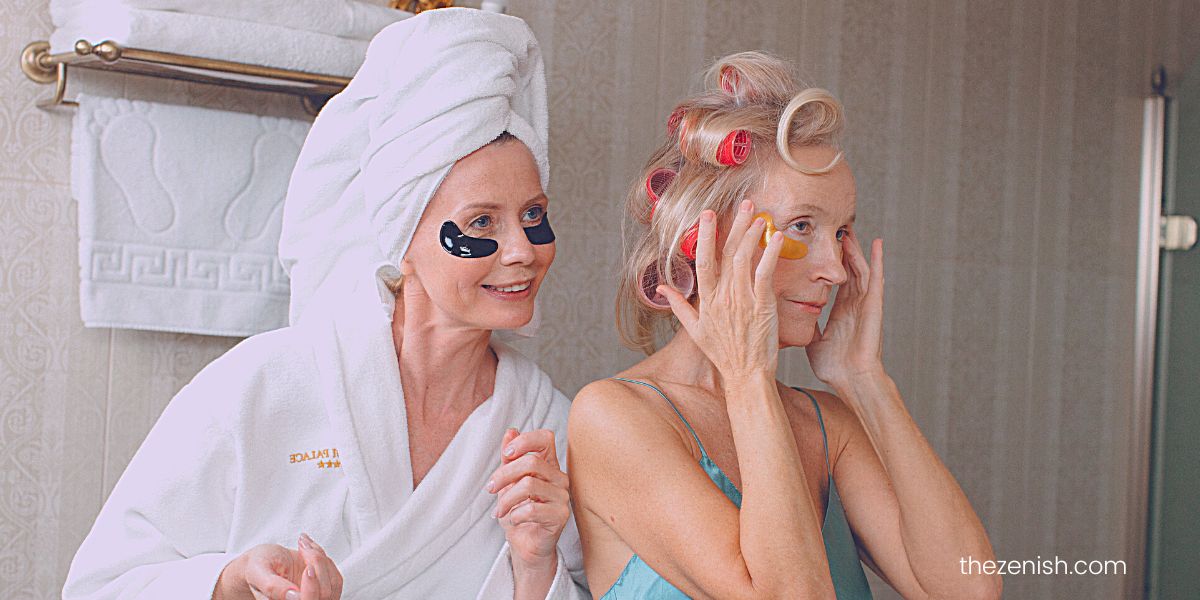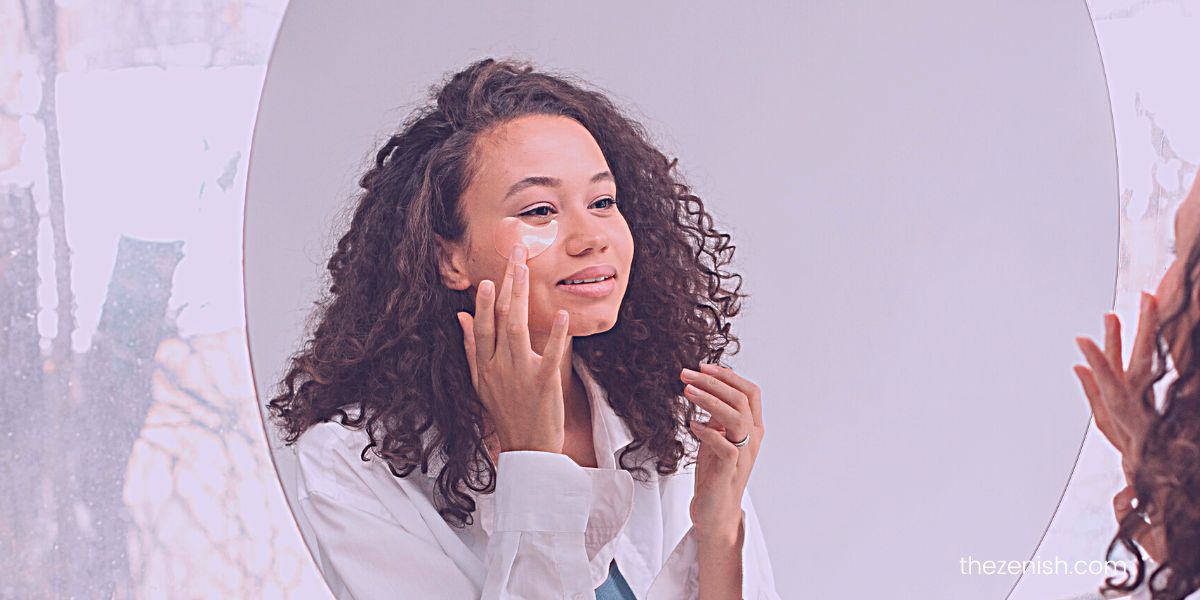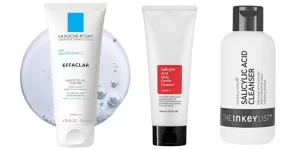
If you’re like me, you’ve probably spent countless hours browsing the internet for the latest and greatest skincare products.
But before you go slathering on that trendy serum, it’s important to understand your skin type.
Why?
Well, for starters, using products that aren’t suited to your skin type can lead to breakouts, irritation, and a whole host of other issues.
Plus, knowing how to determine your skin type and knowing your skin type can help you make informed decisions about your skincare routine and the products you use.
See also: Skincare beginners guide: How to build a skincare routine for all skin types

So, let’s dive into the four main skin types: oily, dry, combination, and sensitive.
The different skin types
Now, let’s talk about the four skin types you need to know about. First up, we have…
Oily skin
Oily skin is characterized by a shiny, sweaty appearance, with visible pores and a tendency to break out. It’s caused by overactive sebaceous glands, which produce too much oil.
Then there’s
Dry skin
Dry skin can leave your face feeling like a desert in desperate need of moisture.
It is characterized by a dull, tight appearance, flaky or rough patches, and a lack of visible pores. This is caused by a lack of oil production in the skin.
Combination skin
Combination skin is a mix of both oily and dry skin, with an oily T-zone (forehead, nose, and chin) and dry cheeks. It’s a combination of both oily and dry skin types.
And last but certainly not least, there’s
Sensitive skin
Sensitive skin is characterized by easily irritated, red, or itchy skin and can be caused by genetics, environmental factors, and certain skincare products (overusing, strong or harsh ingredients). It is the skin type that can react to just about anything.
Knowing which of these skin types you have is helpful when it comes to finding the right products and treatments that will work for you.
So, let’s figure out which skin type you have and get on the road to healthy, happy skin!
How to determine your skin type (step-by-step)

Okay, it’s time to figure out which of these skin types you’ve got going on.
Don’t worry, it’s super easy to do a skin type test at home.
All you need to do is wash your face, pat it dry, and then wait an hour or so without applying any products, not even moisturizer.
After that hour is up, take a look at your skin and pay attention to how it feels.
Does it look shiny and greasy? You might have oily skin.
Is it tight, flaky, or itchy? Hello, dry skin.
If you’re noticing some areas are oily and some are dry, you’ve probably got combination skin.
And if your skin is feeling sensitive, it might be red, itchy, or irritated.
Once you’ve determined your skin type, you can start choosing the right products to keep your skin looking and feeling its best.
But hold up, before you run off and start shopping, let’s talk about how to interpret your results.
If you’re not sure what your skin is telling you, no worries!
I’ve got some tips to help you make sense of it all.
Tips for interpreting the results of your skin type test
So, you’ve done the skin type test and you’ve got your results – now what?
Here are some tips to help you interpret what your skin tells you.
- Oily skin: If you have oily skin, you might notice that your skin looks shiny, especially in the T-zone (forehead, nose, and chin).
- You might also be prone to breakouts and blackheads.
- Dry skin: If you have dry skin, your skin might feel tight, itchy, or flaky. You might also notice fine lines and wrinkles.
- Combination skin: If you have combination skin, you might have an oily T-zone but dry cheeks.
- And if you have sensitive skin, your skin might be easily irritated, red, or itchy.
Once you figure out your skin type, you can start picking out the proper products and treatments.
But always keep in mind that everyone’s skin is different, so don’t be afraid to explore what works best for you!
How do you find out your skin type using a tissue?

If you’re having a tough time finding out your skin type with the first method then another way to determine your skin type is by using the tissue test.
Here’s how to do it:
- Wash your face: Start by cleansing your face with a gentle cleanser and patting your skin dry.
- Wait an hour: Avoid applying any products to your skin for at least an hour.
- Press a tissue to your face: After an hour, press a tissue to different areas of your face, including your forehead, nose, chin, and cheeks. Pay attention to how much oil is on the tissue.
- Observe the tissue: Look at the tissue to see if there is any oil on it.
- Interpret the results:
- Oily Skin: If the tissue has a lot of oil on it, especially in the T-zone (forehead, nose, and chin), then you likely have oily skin.
- Dry Skin: If the tissue has little or no oil on it, then you likely have dry skin.
- Combination Skin: If the tissue has oil on it in the T-zone, but not on the cheeks, then you likely have combination skin.
- Normal Skin: If the tissue has a moderate amount of oil on it, then you likely have normal skin.
Understanding each skin type
Now that you’ve got a handle on the different skin types and how to determine which one you have, let’s talk about the specific characteristics of each one.
Oily skin
For oily skin, you might be prone to excess oil, acne, and enlarged pores.
But the good news is, oily skin tends to age more slowly than other skin types, so you’ll be looking young and fresh for longer!
Dry skin
If you have dry skin, you might notice fine lines, flakiness, and a dull complexion.
Hydration is key for dry skin, so look for products that are ultra-moisturizing.
Combination skin
Combination skin can sometimes be tricky to deal with because you have to cater to two different skin types at once.
You might have to use different products on your T-zone than you do on your cheeks, for example.
Sensitive skin
And last but not least, sensitive skin requires extra gentle care to avoid irritation and inflammation.
Look for Uber gentle products that are fragrance-free and non-irritating to keep your skin happy.
Understanding these characteristics and how they affect your skincare needs is crucial for finding the right products and treatments that will keep your skin healthy and glowing.
So take a little time to get to know your skin, and you’ll be well on your way to your best skin yet.
Tailoring your skincare routine to your skin type

Now that you know what kind of skin you have and what it needs, it’s time to start building a skincare routine that’s tailored specifically to you!
Here’s how to get started.
Tip #1
First and foremost, be gentle with your skin.
No matter what type of skin you have, harsh products and aggressive treatments can be harmful.
Stick with gentle, fragrance-free products if you have sensitive or sensitized skin.
Tip #2
If you have oily skin, look for products that contain salicylic acid or benzoyl peroxide to help control oil and prevent breakouts.
Tip #3
If you have dry skin, look for products that contain hyaluronic acid, glycerin, or ceramides to help lock in moisture.
Tip #4
Combination skin might require different products for different areas of the face, so be sure to pay attention to what your skin needs.
Tip #5
Remember to be patient – it can take a few weeks for your skin to show the benefits of a new skincare routine, so don’t get discouraged if you don’t see results right away.
With a little bit of trial and error, you’ll find the perfect skincare routine that keeps your skin looking awesome.
FAQs
How can I improve my skin type?
Keep in mind that a healthy diet, enough sleep, and enough hydration, as well as protecting skin from sun exposure, can also improve the overall health of your skin.
Here are some general tips to improve your skin type:
Use a gentle cleanser to cleanse your skin twice a day.
Exfoliate your skin 1-2 times a week to remove dead skin cells.
Oily Skin:
- Use products that are non-comedogenic and oil-free.
- Look for ingredients like salicylic acid and benzoyl peroxide to help control oil production and prevent breakouts.
- Avoid using heavy or oily products on your skin, as these can contribute to oiliness.
- Use a lightweight moisturizer to hydrate your skin without clogging your pores.
Dry Skin:
- Use products that are hydrating and formulated with ingredients like glycerin, hyaluronic acid, and ceramides.
- Avoid products that contain alcohol or are overly astringent, as these can strip the skin of its natural oils.
- Use a thicker moisturizer to hydrate your skin and lock in moisture.
- Drink plenty of water to stay hydrated.
Combination Skin:
- Get products that work on both oily and dry skin
- Look for ingredients like salicylic acid to control oil production, and hydrating ingredients to keep the dry areas of your skin moisturized.
- Use a lightweight moisturizer for the oily areas and a thicker moisturizer for the dry areas.
Sensitive Skin:
- Use products that are specifically formulated for sensitive skin, with gentle, hypoallergenic ingredients.
- When it comes to skincare, try to avoid products with fragrances or harsh chemicals, as they may end up irritating your skin.
- Use a lightweight moisturizer to hydrate your skin without causing irritation.
What skin type is more common?

Most people have combination skin.
It’s characterized by having both oily and dry areas on your face.
Your T-zone, which includes your forehead, nose, and chin, is typically oily, while your cheeks are dry.
It’s caused by a combination of factors like genetics, hormonal changes, and environmental factors.
If you have combination skin, you may experience issues such as oily skin in certain areas, dry patches, and breakouts.
Can you change your skin type?
It’s not possible to change one’s skin type simply because one wishes to do so; however, it can change over time due to environmental factors, age, hormones, and other health-related issues.
For example, if you have oily skin, you can reduce its oiliness by following a skincare routine tailored to oily skin and avoiding heavy or greasy products whenever possible.
Similarly, if you have dry skin, using products that are hydrating and formulated with ingredients like glycerin, hyaluronic acid, and ceramides, can help to improve hydration and reduce the dryness of your skin.
However, it’s more unlikely if you have a genetic skin condition like eczema, psoriasis, or rosacea, but you can still improve the symptoms with the right skincare routine and products.
Does everyone have a skin type?
Yes, everyone has a skin type. Skin type is determined by a variety of factors, including genetics, hormones, environmental factors, and lifestyle choices.
Which is better oily or dry skin?
Neither oily nor dry skin is inherently “better” or “worse” than the other.
Both skin types have their own unique characteristics and concerns.
People with oily skin may experience issues such as acne, blackheads, and whiteheads, which is characterized by a shiny appearance, visible pores, and a tendency to break out.

A skincare routine tailored to oily skin can help to control oil production and prevent breakouts.
People with dry skin can experience dullness, tightness, flaky or rough patches, a lack of visible pores, itching, redness, and irritation.
A tailored skincare routine can help to improve hydration and reduce the dryness of the skin.
Ultimately, the best skin type is healthy skin, which can be achieved by following a proper skincare routine, eating a healthy diet, getting enough sleep, staying hydrated, and protecting your skin from sun exposure.
What next?
Before I wrap things up, here are a few additional tips for you to keep in mind.
- First of all, it’s worth noting that your skin type can change over time.
- Hormonal changes, aging, climate, and lifestyle factors can all impact the health and appearance of your skin, so it’s important to stay flexible and adjust your skincare routine as needed.
- If you notice any major changes in your skin – like sudden breakouts or dry patches – don’t be afraid to seek the advice of a dermatologist. They can help you identify any underlying issues and recommend treatments or products that will address your specific concerns.
- And last but not least, don’t forget to take care of your skin from the inside out! Eating a healthy, balanced diet, staying hydrated, and getting enough sleep can all help support the health of your skin and keep it looking its best.



